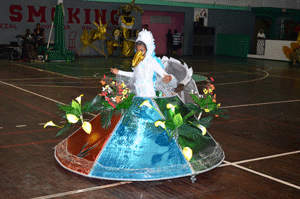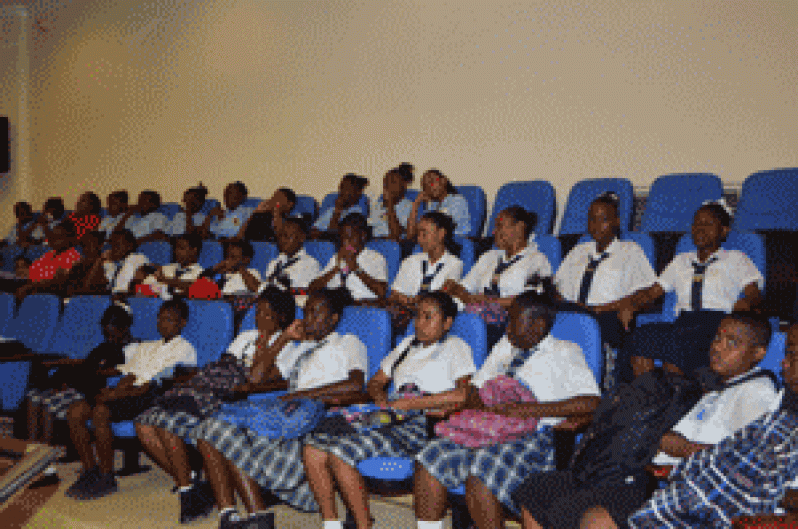 The launch was the highpoint of the conclusion of this year’s celebration of the International Day for Disaster Reduction, in which a symposium under the theme ‘Women and Girls, the invisible force of Resilience’ saw in attendance members of the Civil Defence Commission in Director General Colonel (retired), Chabilall Ramsarup; Deputy Director General, Colonel Francis Abraham; Volunteer Coordinator Major Kester Craig; Education Minister, Priya Manickchand; Secretary-General of the Guyana Red Cross, Ms. Dorothy Fraser; Women’s Advocate Ms. Bonita Harris; Assistant Representative of the World Population Fund (UNFPA), Ms. Patrice La Fleur; and Emergency Operations Specialist, UNICEF’s Mr. Ian Jones.
The launch was the highpoint of the conclusion of this year’s celebration of the International Day for Disaster Reduction, in which a symposium under the theme ‘Women and Girls, the invisible force of Resilience’ saw in attendance members of the Civil Defence Commission in Director General Colonel (retired), Chabilall Ramsarup; Deputy Director General, Colonel Francis Abraham; Volunteer Coordinator Major Kester Craig; Education Minister, Priya Manickchand; Secretary-General of the Guyana Red Cross, Ms. Dorothy Fraser; Women’s Advocate Ms. Bonita Harris; Assistant Representative of the World Population Fund (UNFPA), Ms. Patrice La Fleur; and Emergency Operations Specialist, UNICEF’s Mr. Ian Jones.
The launching saw fourteen volunteers being accredited pins by CDC’s Colonel Ramsarup, and they will now be the first to begin coordinating operations of other volunteer development movements and logistics programmers for training and disaster management in the CDC.
International Day for Disaster Reduction 2012 saw a symposium attended by students from a number of secondary schools. The theme focused on ‘Women and Girls, the Invisible force of resilience’, and brief presentations where made by persons drawn from the society and the UNFPA, among others.
CDC Director-General Col. Ramsarup, in his welcome and opening remarks, congratulated all present, and made special mention of the presenters, who willingly came forward to present on this theme.
 He noted that this symposium could not have been possible without involvement of the UNDP, who had come onboard with the CDC. He emphasized that the theme specifically targeted women and girls, and was fitting for today’s society. He noted that when disaster strikes, it is the women and girls who are mostly affected.
He noted that this symposium could not have been possible without involvement of the UNDP, who had come onboard with the CDC. He emphasized that the theme specifically targeted women and girls, and was fitting for today’s society. He noted that when disaster strikes, it is the women and girls who are mostly affected.
Women, he said, represented more than half of the world’s population, and are among those most affected in disasters. He said that the expertise of women and their experience are critical in disaster risk reduction, as they not only care and prepare for the family, but are in many cases the breadwinners.
He explained that international observance has seen that, in disasters, the menfolk leave the family to seek other employment in order to care for the family, and the brunt of the work at home is shouldered by women and girls.
He pointed out that society should therefore empower women and girls to address sustainable development in the event of disaster.
Secretary-General of the Guyana Red Cross Society, Ms. Dorothy Fraser, in her brief and formal remarks, spoke literally to the school children present at the symposium, as she engaged them in a question-and-answer presentation.
She sought from them the meaning of the word “resilience” as they sat and listened attentively to her presentation, and cooperated fully. She disclosed the meaning and application of the word resilience as she expanded on her topic.
**She sought from them whether they knew what was required of them in the event of a disaster, and whether they knew if there was any plan of action in terms of an emergency shelter and what to do, where to go, and how to get there.
She expressed the willingness of her organisation to commence training groups of ten students at a time in first aid and other related skills. She asked about the garbage situation in the schools and homes from which the students came, making suggestions on how best to keep the area and school clean.
Fraser explained the services of her organisation in working with communities in assessing the capacities of women, girls and others, identifying risks and seeking to have them reduced.
She thanked the CDC for working with the Red Cross Society in assisting to reduce risks and disasters, so the country can be better prepared for disasters.
The statement prepared by the United Nations Secretary General for international Day for Disaster Risk Reduction was read by Mr. Ian Jones in a brief presentation that outlined in detail the role of men in preparing women and girls for disaster.
UNFPA Assistant Rep., Ms. Patrice La Fleur, also presented a detailed outline on what can be done to make women and girls in Guyana resilient to disasters.
A presentation was also made by Women’s Activist Ms. Bonita Harris on how gender inequality makes women and girls more vulnerable to disasters, and a number of short videos were shown on women and girls in disasters across the world.
A detailed presentation introducing the Civil Defence Commission Volunteer Corps was made by volunteer coordinator Major Kester Craig, and the ‘Importance of Volunteers in disaster risk management’ was done by volunteer, Fredrick Granger.



.jpg)









